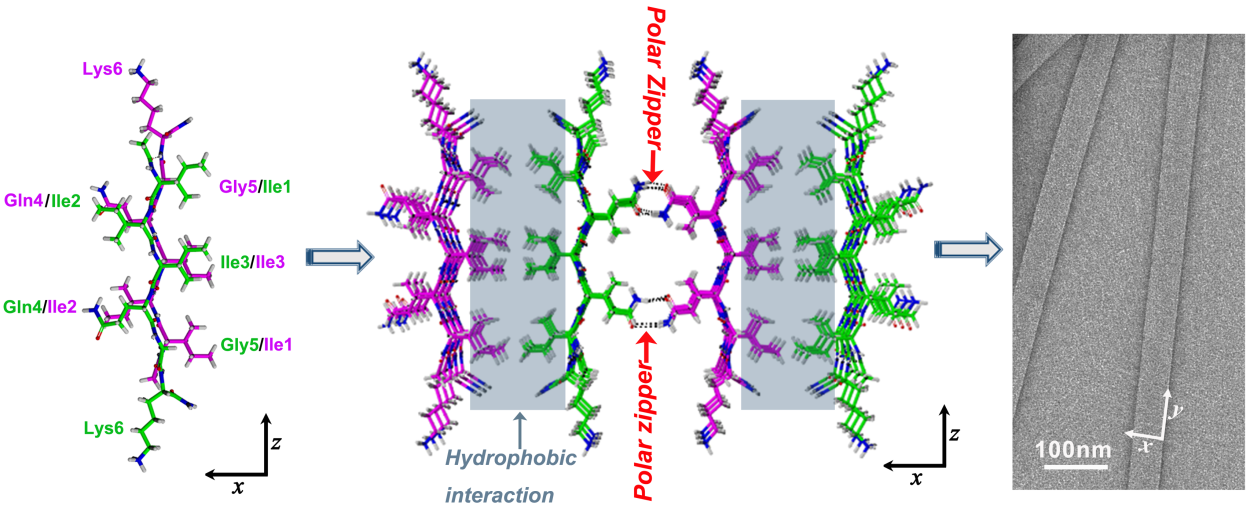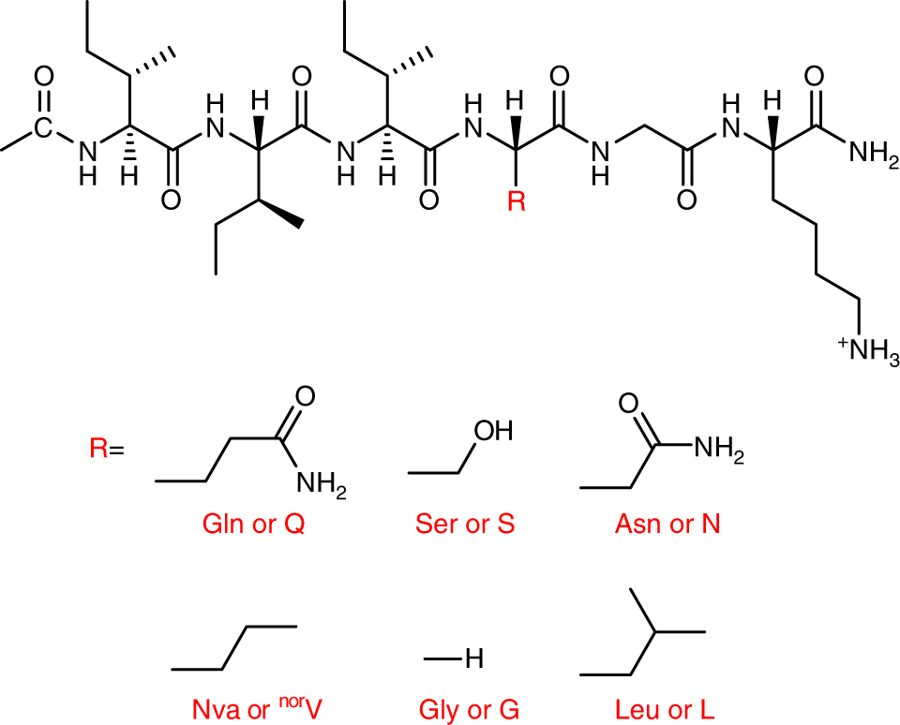Why peptides?
Proteins and peptides are both chains of amino acids, however peptides have much shorter chain lengths. The chemical specificity of amino acids, and the ease with which they can be coupled together, provide exciting possibilities for designing-in functionality and structure. This research exploited the differences in amino acid side chains to manipulate how peptides interact with one another and then self-assemble into larger structures.
Whilst molecular self-assembly is not a process unique to peptides (it is how surfactant molecules form liquid crystals, for example), peptide self-assembly exhibits some special features. One example is something called the 'polar zipper', proposed 25 years ago by Max Perutz. This has previously been shown to form between beta strands of peptides via side chain interactions, and implicated in some types of neurodegenerative disease. However, this idea has now been revolutionised in new research conducted by the China University of Petroleum and The University of Manchester where scientists used neutron scattering to demonstrate a novel form of polar zipper between neighbouring beta sheets and not just between the strands within a beta sheet (Figure 1).

Figure 1. Polar zippers between neighbouring beta sheets leading to the formation of wide and rigid nanoribbons.
What is a beta sheet?
There are 20 amino acids, each with different properties, and combining these produces functionally different peptides. The sequence of amino acids in a peptide is termed the primary structure. This then gives rise to different types of secondary structure, such as beta strands, beta sheets, beta hairpins and alpha helices, depending on how each peptide chain folds and the stabilisation that is imparted by interactions called hydrogen bonds and disulphide bridges.
A beta sheet forms as a result of hydrogen bonding interactions between peptide backbones of parallel or antiparallel beta strands, which as the name suggests are mostly linear. In contrast, the 'polar zipper' mechanism refers to hydrogen bonding interactions between the amino acid side chains on adjacent beta strands.
Designing Peptides
The research involved taking short peptides with the general sequence CH3CO-I3-X-G-K-NH2, where residue X was replaced by one of six different amino acids – either the uncharged polar glutamine, serine or asparagine, or the hydrophobic glycine, leucine or norvaline – and looking at the nanostructures formed by the resulting secondary structures (Figure 2). In these peptides, the I3 motif is highly hydrophobic, and the amino acid K is hydrophilic. In this way, the researchers were able to systematically compare the secondary structures formed and analyse the 'polar zipper' mechanism.

Figure 2 The molecular structures of the peptides designed to aid understanding of the polar zipper mechanism and peptide assembly. R depicts the side chain substitutions where position X is either Glutamine (Q), Serine (S), Asparagine (N), Glycine (G), Norvaline (Nva) or Leucine (L).
SANS provides insights into peptide assembly
The structures that formed were characterised by different methods of analysis including using small angle neutron scattering (SANS) at the ISIS Facility, a technique extensively used to study nanoparticles, micelles, microemulsion droplets, and polymer molecules. The instruments SANS2D and LOQ were used to make in situ measurements of the self-assembled nano-structures that formed in aqueous solution. Changing the amino acid X lead to variations in the size and shape of the larger-scale ordering. This implied there were different modes and degrees of beta sheet packing, which is interesting as it could shed light on how certain amino acid motifs in peptides contribute to disease. The data obtained using SANS was complemented by transmission electron microscopy (TEM) and atomic force microscopy (AFM) data, and by molecular simulation. Unexpectedly, the results revealed that the nanostructures were formed through multi-layered stacking of the beta sheets of varying thicknesses, demonstrating the sensitivity of the structures produced to the underlying amino acid sequence.
When residue X was an uncharged polar residue, the polar zipper mechanism resulted in more rigid secondary structures, which subsequently assembled into nanoribbons (Figure 3). However, the hydrophobic amino acid insertions resulted in less stable, more amyloid-like, nanofibers with no polar zippers. This finding could provide exciting prospects for future Alzheimer's research as the disease is thought to be associated with the formation of bundles (plaques) of amyloid fibers.
By demonstrating that polar zippers can interlink many beta sheets together to produce flat, wide, ribbon-like nanostructures ,this research opens the door to the possibility of designing more intricate self-assembled nanostructures in the future!
 Figure 3 Nanoribbons formed from the designed peptide with the sequence Ac-I3QGK-NH2 after a week of incubation. These distinctive structures could be of interest for a range of scientific applications.
Figure 3 Nanoribbons formed from the designed peptide with the sequence Ac-I3QGK-NH2 after a week of incubation. These distinctive structures could be of interest for a range of scientific applications.
Future Applications
This research could improve the development of peptide based materials already used in artificial enzymes, antibacterial and anticancer agents, cell culture scaffolds and even biological semiconductors, with the added benefit of improved biodegradability and biocompatibility! The commercial potential is exciting but this research has also provided ground-breaking insights into how peptides form to further the much needed understanding of a process that plays a huge role in health and disease.
Research Date: November 2018
Further Information
The full publication can be viewed in Nature Communications.
Browse all our science highlights here.
See here for further details on SANS2D and LOQ instruments.
